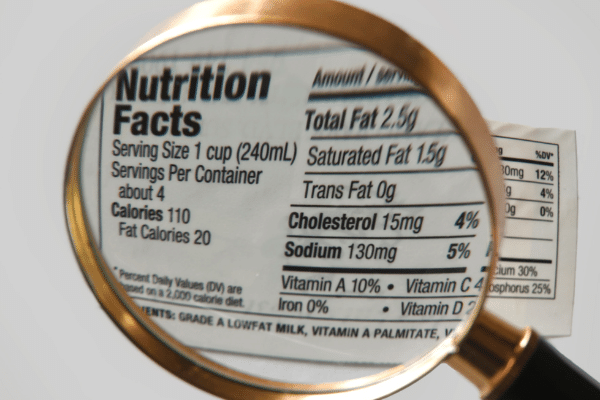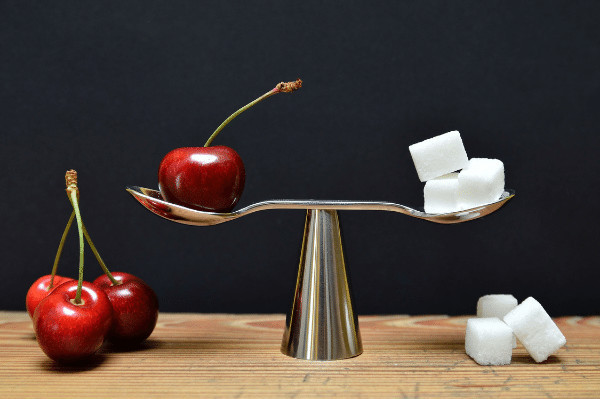Natural sugar vs added sugar, do you know the difference? Natural sugars are found in whole, unprocessed foods. Added sugar is what you add during the cooking/baking process or at the table before you eat. White sugar, brown sugar, and corn syrup are some examples of added sugars.
While natural sugars are sweet, they have the benefit of giving you added fiber, vitamins, and antioxidants. Fruit has natural sugar in it and gives you the benefits of antioxidants, fiber, and vitamins. The only thing added sugar adds is calories.
This post contains affiliate links. If you click on and purchase through one of those links, you won’t pay a penny more, but we’ll get a small commission, which helps keep our website operating. Thanks! As an Amazon Associate, I earn from qualifying purchases.
Natural Sugar vs Added Sugar
There are many natural sugars in food. When you read the labels on the processed products you buy at the grocery store, you will discover how much added sugar is there. Some added sugars on labels are given names like dextrose, glucose, and fructose. If sugar is one of the first ingredients on the list, you may want to limit or avoid that product.
Chances are you already know too much sugar isn’t good for your health. So how much added sugar per day is okay? According to the American Heart Association, the amount of recommended added sugar per day for men is 38 grams, or about 9 teaspoons a day, and for women, about 25 grams or 6 teaspoons a day.
What Does Added Sugar Do to Your Body?
Does Sugar Make You Fat?
It probably comes as no surprise, the more sugar you eat the more you will weigh. Added sugar is empty calories that do not give you added nutrients, and those calories can add up quickly. So, if you exceed the number of calories you need, you will gain weight.
It may however, surprise you to know that forty-seven percent of the added sugars in our diet comes from sugar-sweetened beverages such as soda, energy drinks, sports drinks, sweetened flavored waters, and sweetened alcoholic beverages. Research shows that drinking sugar-sweetened beverages causes weight gain and puts people at a higher risk for type 2 diabetes.
Many of the other sources of added sugar come in the form of pastries, cookies, cakes, candy, dairy desserts (ice cream) and sugar-coated cereals.
Blood Sugar Highs and Lows
Added sugar raises your blood sugar quickly, with a burst of energy. When those blood sugar levels drop, you get a “sugar crash” and may feel jittery and anxious.
Your Brain
You get a huge surge of the feel-good hormone dopamine in your brain after consuming a quantity of added sugars. As your body gets used to the dopamine rush, it wants more and more. That is when you begin craving sweets to get that same feeling of pleasure.
Studies show that a high intake of added sugar is linked to a greater risk of depression in adults.
Your Teeth
Sugar is bad for your teeth. Unless you clean your teeth after eating sugary things, the bacteria that causes cavities in your teeth, can do just that.
Inflammation
Too much sugar increases inflammation in your body, which can cause pain.
The Liver
According to WebMD, too much added fructose or high fructose corn syrup is processed in the liver. In large amounts it can do damage to the liver. In time it causes:
- Non-alcoholic fatty liver disease (NAFLD). This is seen as excess fat built up in the liver.
- Non-alcoholic steatohepatitis (NASH). This is fatty liver, inflammation, and “steatosis”, which is scarring of the liver. The scar eventually cuts off the blood supply to the liver. Many times, this develops into cirrhosis which makes a liver transplant necessary.
Your Heart
Excess sugar can affect all the arteries in your body. The artery walls get inflamed, they grow thicker, and become stiff. This can damage your heart from the additional stress placed on it.
This, in turn, leads to heart disease, heart failure, heart attacks, and strokes. Studies show that when one quarter of your calories come from added sugar you are twice as likely to die of heart disease than if only 10% of your total calories came from added sugar.
Your Pancreas
The pancreas pumps out insulin when you eat. If you are eating way too much sugar, eventually, your overworked pancreas will break down, your blood sugars will rise, and you will be on the path to type 2 diabetes and heart disease.
Your Kidneys
Too much sugar can lead to kidney damage in those who have diabetes. When the blood sugar levels become too high, the kidneys release excess sugar into your urine. Uncontrolled diabetes can damage your kidneys which can lead to kidney failure.
Sexual Health
“One common side effect of chronically high levels of sugar in the bloodstream is that it can make men impotent”, explains Brunilda Nazario, MD, WebMD’s Leas Medical Director. The reason for this is it affects your circulatory system, which controls the blood flow throughout the body, and it needs to be working properly to keep men from being impotent.
How Much Added Sugar Is in Coke?
There is around 10.6 grams of sugar per 100ml. That means a 330ml can of coke contains about nine teaspoons of sugar, and a 500ml bottle, contains more than 50 grams of sugar that is over 12 teaspoons!
How to Make Healthy Food Choices.

Read the food labels! It is a good idea to check the label for: nutrients, quality of ingredients, whether it is diabetic friendly, or keto friendly, the presence of artificial additives and preservatives.
Do foods help you stay full longer? Do they contain adequate fiber, and protein? Are they made of quality ingredients? Answering these questions will help you make wise food choices.
Tips for Using Natural Sugar vs Added Sugar
- Make fruit your desert of choice on most days. On special occasions, you can bring out the traditional treats.
- Cut back on table sugar, white or brown, syrup, honey, agave, and molasses. Take baby steps until you have weaned yourself from many cravings for sweets.
- Read food labels! Choose products with the smallest amounts of added sugars. Check the ingredient list for ingredients ending in letters like “ose” such as sucrose and dextrose.
- Add your own fruit. Instead of buying flavored yogurts or adding sugar to foods like your cereal or oatmeal – add fresh or frozen fruit. Canned or dried fruit can also be used. Look for fruit packed in water or natural juice, instead of heavy syrup. Another option is to drain the heavy syrup from the fruit before serving.
- Reduce the sugar in some recipes. Some recipes work very well even if you decrease the sugar by one-third or one-half. Your family may never notice the difference. Experiment with different extracts like almond, vanilla, orange, and lemon. Spices like allspice, nutmeg, ginger, or cinnamon can add flavor to your baking. Try switching some of the sugar for equal parts of unsweetened applesauce.
- Regular soda, energy drinks, and other sugar sweetened beverages contain lots of sugar. Unsweetened coffee, tea, and milk are better alternatives. The best, and least expensive choice is always water!
Applesauce
You can easily make applesauce by peeling the apples and taking out the seeds. Put them on the stove with a small amount of water and steam them on med/low until they are cooked down into applesauce. Add some cinnamon for flavor if you like.
There are many recipes online for low-sugar or sugar-free barbeque sauce.
Breakfast Cereal
Breakfast cereals are convenient and quite popular with busy moms and dads. They are a big bonus just getting out of the door on a busy weekday morning. However, many of these cereals are far from nutritious. Not only are they low in protein and fiber, but they are made with a high percentage of sugar.
High added sugar is linked with an increased risk of chronic diseases like heart disease, obesity, non-alcoholic fatty liver disease. It also can lead to increased blood sugar levels in people with diabetes.
Flavoured oatmeal – use regular oatmeal and add your own fruit while it is cooking or after it has already cooked. Apples and cinnamon while cooking, add blueberries once it is ready to be served.
Here are some sugar free cereals you may like to consider.


Protein bars
Many protein bars or granola bars have as many calories as a candy bar. Read the labels. Choose a nut-based bar with less than 6 grams of sugar per serving.

Jams and Jelly
Look for jams and jelly made with extra fruit and little or no sugar.
Popsicles or Ice cream
Try taking fruit and blending it in a blender to create your own.
Salad Dressing and Spaghetti Sauce
These often have hidden sugar in the ingredients. Read the labels or make your own.
Sports Drinks
Use them only when exercising for an hour or more, otherwise opt for tea or coffee
Sugar is often hidden in a North American diet. Become more mindful and read labels. As you become more aware of the sugars in your diet, you can take small steps in cutting back on the sugar until it reaches the American Heart Association recommendations in your diet.
Instead of thinking of eliminating things from your diet, consider it as adding healthy choices. You will not feel deprived and will not need to stock up on all the unhealthy sugars in the North American diet. Be patient with yourself as you adjust.
Keep track of what you eat each day. In this way you will become more mindful as to how much natural sugar vs added sugar you have in your diet, and what you are including in your food intake each day.
Please Leave a Comment
I would love to hear from you. How do you use natural sugar in your diet?
Disclaimer: If you have any concerns or questions about your health, you should always consult with a physician or other healthcare professional. No content on this site should be substituted for direct medical advice from your doctor or other qualified healthcare practitioner. The information contained here is for informational purposes only. It is from my research and personal experience.

